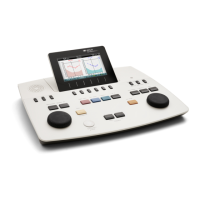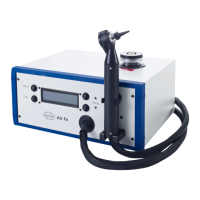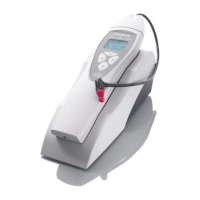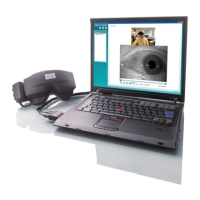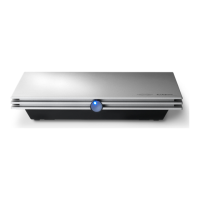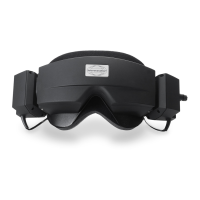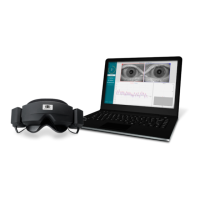Affinity
2.0
Additional Information Page 133
Because of this possibility, the “true” hearing loss at a given frequency may be greater than suggested by the
audiometric threshold at that frequency. Also, for this reason, dead regions are not easy to diagnose from
the pure-tone audiogram, although a hearing loss greater than 70 dB is often associated with a dead
region.
11,12
A dead region can be characterised in terms of the range of CFs that would normally be associated with that
region. In other words, a frequency-to-place map is used to relate the cochlear location at each edge of the
dead region to frequency. This is illustrated in Figure 2. Say, for example, that the IHCs are non-functioning
over a region of the basilar membrane having CFs in the range 2500 to 20000 Hz. One might describe this
as a dead region extending from 2500 Hz upwards. The lower “edge frequency” of the dead region in this
example is 2500 Hz. Henceforth, the edge frequency is denoted fe.
The TEN(HL) Test for Diagnosing Dead Regions in the Cochlea
The TEN(HL) test for diagnosing dead regions was designed to be quick and easy to administer and hence
suitable for use in clinical practice. The development and validation of the first version of the test are
described in Moore et al.
8
The test involves measuring the threshold for detecting a pure tone presented in a
background noise called “threshold-equalizing noise” (TEN). This is why the test is called the TEN test. The
noise was synthesised in such a way that the threshold for detecting a tone in the noise, specified in dB SPL,
was approximately the same for all tone frequencies in the range 0.25 to 10 kHz, for people with normal
hearing. The masked threshold is approximately equal to the nominal level of the noise specified in dB SPL.
When the pure-tone signal frequency falls in a dead region, the signal will only be detected when it produces
sufficient basilar-membrane vibration at a remote region in the cochlea where there are surviving IHCs and
neurons. The amount of vibration produced by the tone at this remote region will be less than in the dead
region, and so the noise will be very effective in masking it. Thus, the signal threshold is expected to be
markedly higher than normal. Moore et al.
8
proposed the following rule: a dead region at a particular
frequency is indicated by a masked threshold that is at least 10 dB above the absolute threshold and 10 dB
above the nominal noise level.
To make the test easy to administer, the TEN test was recorded on a CD; the noise was on one channel and
test tones were on the other channel. For this implementation of the test, the signals from the CD were fed
through a two-channel audiometer. The methods used to conduct the test were similar to those used for
conventional pure-tone audiometry, except that the signal threshold was measured in the presence of a
continuous background noise.
A problem with the first version of the TEN test was that the clinician had to measure absolute thresholds
(audiometric thresholds) twice, once using the tones generated by the audiometer, with level specified in dB
HL, and once using the tones from the CD, with level specified in dB SPL. This was inconvenient for the
clinician. To overcome this problem, a second version of the TEN test was developed in which the noise
was designed to give equal masked thresholds in dB HL for all frequencies from 500 to 4000 Hz, for normally
hearing people.
13
This version is called the “TEN(HL)” test. As all calibrations were in dB HL, absolute
thresholds could be measured either using the tones generated by the audiometer, or using the test tones
from the CD; the results were expected to be very similar. However, the TEN(HL) test can only be used with
specific headphones; with the current version of the test, suitable headphones are TDH39, TDH 49 and
TDH50.
Another advantage of the second version of the test is that the noise has been designed to have minimal
amplitude fluctuations; such noise is called “low-noise noise”.
14
Figure 3 shows the spectrum of the noise
(top) and a sample of the waveform (bottom). Note that all peaks and dips in the waveform are of similar
magnitude. This characteristic allows high noise levels to be used without significant distortion being
produced by the audiometer or earphone. Hence, testing is possible for more severe hearing losses than
could be assessed with the earlier version, without any special equipment being required.
The criteria for diagnosing a dead region are similar to those for the earlier test: a dead region at a particular
frequency is indicated by a masked threshold that is at least 10 dB above the absolute threshold and 10 dB
above the nominal noise level in dB HL.
Implementation of the TEN(HL) Test in Interacoustics Audiometers
The implementation of the TEN(HL) test in the Affinity
2.0
and Equinox
2.0
PC-based Interacoustics
audiometers makes it easy and simple to administer the TEN(HL) test. There is no need to have any
equipment external to the audiometer. A pre-defined setup for performing the TEN(HL) test can be selected
from a drop-down menu of “User protocols”. One ear at a time is tested, and on-screen boxes are used to
determine whether the TEN plus test tone are delivered to the right ear or the left ear. Possible frequencies
for the test tone are 500, 750, 1000, 1500, 2000, 3000 and 4000 Hz.
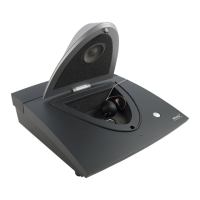
